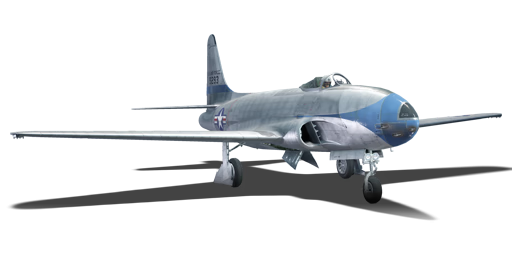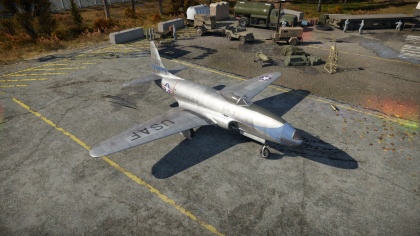F-80C-10
Contents
| This page is about the aircraft F-80C-10. For the other version, see F-80A-5. |
Description
The F-80C-10 Shooting Star is a Rank V American jet fighter
with a battle rating of 7.7 (AB/RB) and 7.3 (SB). It was introduced in Update 1.33. It is found under the F-80 bracket, immediately after the F-80A-5.
The greatest performance upgrade from the A-5 to the C-10 is that the C-10 comes with WEP. This additional power significantly increases acceleration, allowing you to match that of the British Meteor series. It also allows for a last-resort method to escape if you happen to get jumped on. With the WEP comes with fuel management. If you opt for maximum performance by selecting 9 minutes of fuel, you will run out of fuel quickly if you choose to WEP for the entire match.
General info
Flight Performance
Describe how the aircraft behaves in the air. Speed, manoeuvrability, acceleration and allowable loads - these are the most important characteristics of the vehicle.
| Characteristics | |||||||
|---|---|---|---|---|---|---|---|
| Stock | |||||||
| Max Speed (km/h at sea level) |
Max altitude (meters) |
Turn time (seconds) |
Rate of climb (meters/second) |
Take-off run (meters) | |||
| AB | RB | AB | RB | AB | RB | ||
| 891 | 884 | 12500 | 24.4 | 25.6 | 18.9 | 17.7 | 850 |
| Upgraded | |||||||
| Max Speed (km/h at sea level) |
Max altitude (meters) | Turn time (seconds) | Rate of climb (meters/second) |
Take-off run (meters) | |||
| AB | RB | AB | RB | AB | RB | ||
| 915 | 903 | 12500 | 23.7 | 24.0 | 32.2 | 25.2 | 850 |
Details
| Features | ||||
|---|---|---|---|---|
| Combat flap | Take-off flap | Landing flap | Air brakes | Arrestor gear |
| ✓ | ✓ | ✓ | ✓ | X |
| Limits | ||||
|---|---|---|---|---|
| Wing-break speed (km/h) |
Gear limit (km/h) |
Combat flap (km/h) |
Max Static G | |
| + | - | |||
| 990 | 380 | 560 | ~11 | ~4.5 |
| Optimal velocities | |||
|---|---|---|---|
| Ailerons (km/h) |
Rudder (km/h) |
Elevators (km/h) |
Radiator (km/h) |
| < 482 | < 600 | < 640 | N/A |
| Compressor (RB/SB) | ||
|---|---|---|
| Setting 1 | ||
| Optimal altitude | 100% Engine power | WEP Engine power |
| 0 m | 1980 kgf | 2,396 kgf |
Survivability and armour
- 12.7 mm steel - behind pilot
- 10 mm steel - in front of pilot
- 38 mm bulletproof glass - armoured windscreen
Armaments
Offensive armament
The F-80C-10 is armed with:
- 6 x 12.7 mm M3 Browning machine gun, nose-mounted (300 rpg = 1,800 total)
Suspended armament
The F-80C-10 can be outfitted with the following ordnance:
- 2 х 1000 lb AN-M65A1 bomb
- 8 х 127 mm HVAR rockets
Usage in battles
Like most American props and tech, your best option to attack is Boom and Zoom. At the start of the match, fly out towards the edge of the map. Make light climbs at 2.5 degrees to 300 meters (1,000 ft) and dive down to sea level to convert it into speed. Rinse and repeat until you have reached 400 km/h (350 knots), then zoom climb at 30 degrees. Once you have slowed down to 287 km/h (250 kt), continue to climb at a solid 15-20 degrees. Optimally, you should have between 3,300 - 4,500 m (11,000 - 15,000 ft) depending on how high the highest enemy is, before turning in towards the area of conflict (continue to climb or maintain altitude). Only once you have selected a target should you dive and make your pass. Always keep your energy high, whether it be speed or altitude. Your greatest advantage is speed, as the F-80 is faster than almost every other jet at its rank.
Defensive flying and rolling scissors is an option with the hydraulic boosters upgrade, however, you risk losing too much energy, and your attacker may choose to break off and try again while you are struggling to maintain lift.
If you are given an awkward firing angle (e.g.: you are directly vertical to your enemy and must pull 10G+ to line up a shot) or you fail to destroy them on your first pass, slowly pull your aircraft back up into a straight vertical climb to recover as much altitude as possible. If you persist on knocking out your target, you risk crashing into the ground from control stiffening or getting strafed by another enemy because you are losing your energy in a dogfight.
Manual Engine Control
| MEC elements | ||||||
|---|---|---|---|---|---|---|
| Mixer | Pitch | Radiator | Supercharger | Turbocharger | ||
| Oil | Water | Type | ||||
| Not controllable | Not controllable | Not controllable | Not controllable | Separate | Not controllable | Not controllable |
Modules
| Tier | Flight performance | Survivability | Weaponry | ||
|---|---|---|---|---|---|
| I | Fuselage Repair | Compressor | Airframe | Offensive 12 mm | |
| II | New Boosters | FRC mk.2 | |||
| III | Wings Repair | Engine | Cover | New 12 mm MGs | |
| IV | G-suit | FLBC mk.1 | |||
Pros and cons
Pros:
- Good acceleration and climb rate.
- Effective weapons.
- Can outturn Mig-15's when the need arises.
Cons:
- Relatively slow dive speed.
- Average level flight speed.
- Poor turn rate at 4-500 km/h.
- Overall useless in a uptier, it is just too slow.
- Just 100 seconds of WEP in RB, it is only there for emergencies.
History
Describe the history of the creation and combat usage of the aircraft in more detail than in the introduction. If the historical reference turns out to be too big, take it to a separate article, taking a link to the article about the vehicle and adding a block "/ History" (example: https://wiki.warthunder.com/(Vehicle-name)/History) and add a link to it here using the main template. Be sure to reference text and sources by using <ref>, as well as adding them at the end of the article. This section may also include the vehicle's dev blog entry (if applicable) and the in-game encyclopedia description (under === Encyclopedia Info ===, also if applicable).
Media
Excellent additions to the article would be video guides, screenshots from the game, and photos.
See also
Links to the articles on the War Thunder Wiki that you think will be useful for the reader, for example:
- reference to the series of the aircraft;
- links to approximate analogues of other nations and research trees.
External links
Paste links to sources and external resources, such as:
- topic on the official game forum;
- encyclopedia page on the aircraft;
- other literature.
| USA jet aircraft | |
|---|---|
| Fighters | |
| F9F | F9F-2 · F9F-5 · F9F-8 |
| F-80 | F-80A-5 · F-80C-10 |
| F-84 | F-84B-26 · F-84F · F-84G-21-RE |
| F-86 | F-86A-5 · F-86F-25 · F-86F-2 · F-86F-35 |
| F-89 | F-89B · F-89D |
| F-100 | F-100D |
| F-104 | F-104A · F-104C |
| F-4 | F-4C Phantom II · F-4E Phantom II · F-4J Phantom II · F-4S Phantom II |
| F-5 | F-5A · F-5C · F-5E · F-20A |
| F-8 | F8U-2 · F-8E |
| F-14 | F-14A Early · ▄F-14A IRIAF · F-14B |
| F-15 | F-15A · F-15C MSIP II · F-15E |
| F-16 | F-16A · F-16A ADF · F-16C |
| Other | P-59A · F2H-2 · F3D-1 · F3H-2 · F4D-1 · F11F-1 |
| Strike Aircraft | |
| FJ-4 | FJ-4B · FJ-4B VMF-232 |
| A-4 | A-4B · A-4E Early |
| A-7 | A-7D · A-7E · A-7K |
| AV-8 | AV-8A · AV-8C · AV-8B Plus · AV-8B (NA) |
| A-10 | A-10A · A-10A Late · A-10C |
| F-111 | F-111A · F-111F |
| Other | A-6E TRAM · F-105D · F-117 |
| Bombers | |
| B-57 | B-57A · B-57B |





